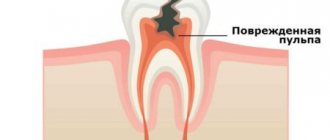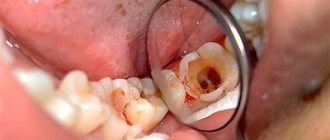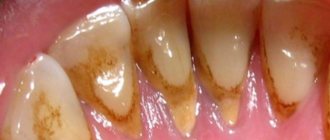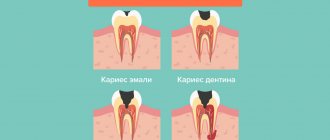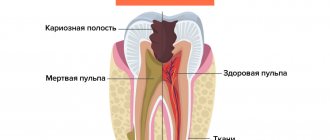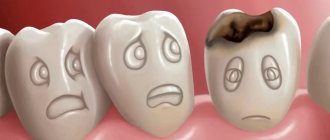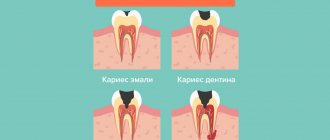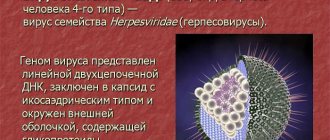Number of roots in human teeth
There can only be one dental crown, but the number of roots a tooth has depends on its location and purpose. The number of roots is also influenced by hereditary factors. It is possible to determine how many roots a tooth has only with the help of an x-ray. The inner part of the tooth (root) makes up about 70% of the entire tooth.
Factors influencing the number of roots:
- Location of the tooth.
- The purpose of the tooth, its functionality (chewing or frontal).
- Genetic predisposition.
- Patient's age and race. In the European race, the number of dental roots is very different from the Negroid and Mongoloid races.
Types of root canals
As noted above, the internal structure of each individual element has its own individual characteristics. But there is also a classification that makes it possible to group various options for the structure of dental canals into several categories:
- for one root there is one passage and one apical foramen,
- the root has several branches that connect closer to the apical foramen,
- two branched passages with one mouth and two apical openings,
- in one root, the cavities are connected and separated several times,
- three canals emerge from the same orifice but approach three different apical foramina.
The internal structure of each individual tooth has its own individual characteristics.
The number of roots and canals may be the same, but more often their number differs. In this case, cavities of various types may be present in one chewing premolar or molar.
Teeth numbering system
Dentists have developed a system in which all teeth have their own serial number. The numbering system for the teeth of the lower and upper rows will not allow you to “get confused” in the teeth.
The first number is the incisors - the frontal teeth of the upper and lower rows. There are two teeth on each side (left and right): No. 1 - central, No. 2 - lateral, behind which there are fangs, numbered No. 3. The small molars have numbers 4 and 5.
All of the listed teeth have one cone-shaped root.
Teeth No. 6, 7, 8 - large molars have three roots, and tooth No. 6 of the lower row has one root, with the exception of tooth No. 8, which can have 3 or even 4 roots.
What is a human tooth made of?
The visible part or crown is covered with a layer of enamel - the strongest tissue in the human body. Beneath it is dentin, and then the walls of the pulp chamber. The pulp (nerve) is a neurovascular bundle that smoothly passes into the root canals. At the very end of the root there is a small apical opening - nerve endings, vessels and capillaries pass through it.
The photo shows the structure of the tooth
Thus, if for some reason the pulp becomes inflamed, the pathological process spreads very quickly through the canals. Essentially, these are communicating vessels, so if one of the passages is missed during treatment and filling, the inflammatory process will continue to develop and ultimately lead to the need to completely remove the diseased element.
How many canals are there in teeth?
The number of tooth canals does not always coincide with the number of roots. The number of channels can only be determined using x-rays. The upper incisors usually have two or three canals. Some teeth have only one canal, which branches into two parts.
Number of canals in teeth:
- Upper Lower four – 1, less often 2 channels;
- Upper second – 1, less often 2 and even 3 channels;
- Bottom five – one channel;
- Upper first molar 3, 4 canals;
- Lower first molar – 3, less often 2 canals;
- Upper and lower seven – 3, 4 channels.
Features of the structure of teeth, their roots and canals
There are no two identical root dental systems, which is explained by the purely individual structure of a person’s teeth. In addition, the root system of incisors, canines and molars is arranged in accordance with their purpose:
- Ones and twos (incisors) are needed for biting food.
- Fours and fives (premolars) perform the initial chewing function.
- Sixes and sevens completely grind food.
Based on this, it becomes clear that the seventh tooth requires more nutrients than the fifth. It must be strong and hardy, therefore it has a more developed channel system. Despite the fact that the 6th tooth in the lower jaw performs the same functions as the seventh, it usually has fewer canals. This is due to the fact that there is less chewing load on it.
For a detailed study of the structure of the dentofacial apparatus of a particular patient, radiographic examination is used.
Tooth structure
Each dental unit consists of:
- crowns - the area above the gum;
- neck - the area between the crown and the root;
- root - the area under the gum.
Inside the crown is the pulp, which passes into the root canals. At the end of the root there is a small apical opening through which blood vessels and nerve endings pass, starting from the main neurovascular bundle and ending in the pulp.
When a person’s pulp becomes inflamed, not only it, but also all root canals need to be cleaned of infected tissues, since they are “communicating vessels.” If even one canal is left uncleaned, pathogenic microorganisms will continue to develop inside the dental unit, which will lead to its removal. That is why the doctor must know the exact number of canals in the tooth.
How many nerves are there in a human tooth?
Thanks to the nerve, the tooth can respond to external stimuli. After removing the pulp and filling the canals, the dental unit loses sensitivity, as it is deprived of a nerve. But due to the removal of blood vessels, problems begin with its blood supply and mineralization. The crown becomes less durable and more prone to various chips and breaks. The enamel quickly darkens, and it cannot be properly bleached even with strong chemicals.
Before removing the pulp, the patient is sent for an x-ray to find out how many canals are in the operated tooth: a person has only one dental nerve in a tooth, but there may be several canals
. This preparation allows for depulpation to be carried out competently and quickly.
Types of Root Canals
There are several options for the structure of dental canals:
- in the root there is one canal passage, which corresponds to one apical foramen;
- in the root there are several canal branches that connect in the area of a single apical foramen;
- two different branched passages have one mouth and two apical openings;
- canal cavities in one root merge and diverge several times;
- three root canal passages emerge from the same orifice, but have 3 different apical openings.
There can be as many channels as there are roots, but often their number differs. Several types of canals may be present in one molar and premolar.
How many canals in a person’s teeth - table
According to statistics, the number of channels depends on the depth of the tooth.
: The deeper it is located in the jaw, the more canals it has. This is due to the increased load on the molars located at the base of the dentition.
Typically, teeth in the upper jaw have more canals. But this pattern is not observed in all patients.
The table below presents average statistical data on how many canals are in a person’s teeth above and below.
| Dental unit | Number of channel passages | |||
| Fangs | Upper | 1 | ||
| Lower | 2 | |||
| Incisors | Upper | 1 | ||
| Lower | Central | in most cases 1, less often 2 | ||
| Lateral | 1 or 2 (about the same probability) | |||
| Premolars | Upper | First | most often 2, but sometimes first premolars with 1 or 3 canals are found | |
| Second | in most cases 2, sometimes 1 or 3 | |||
| Lower | First | 1 or 2 | ||
| Second | 1 | |||
| Molars | Upper | First | 3 or 4 with equal probability | |
| Second | in most cases 3, sometimes 4 | |||
| Third | around 5 | |||
| Lower | First | most often 3, sometimes 2 or 4 | ||
| Second | usually 3, but there are roots with 4 channels | |||
| Third | no more than 3 | |||
Number of canals in teeth in the lower jaw
The teeth on the lower and upper jaws are significantly different from each other. This is partly due to the uneven load and different functions. Typically, teeth in the lower jaw have fewer canals. But each specific case requires detailed study. Therefore, the dentist first sends the patient for an x-ray, and only then proceeds to open the crown and treat pulpitis.
It is impossible to start treating caries and pulpitis based only on encyclopedic information, because:
- The 6th tooth of the lower jaw can have any number of canals - from 2 to 4;
- in the 5th tooth below there is usually only 1 canal, but in approximately 10% of patients there are quints with 2 canals;
- In the 4th tooth there is usually only 1 canal, but in about a third of cases there are 2.
The eighth tooth on the lower jaw is the most “unpredictable”. Exactly how many canals are in the wisdom tooth located below can only be determined using x-rays. Officially, there are no more than 3 of them, but during the treatment of caries, additional cavities usually open. It is precisely because of its incomprehensible structure and inconvenient location that the figure eight is most often removed.
It is impossible to treat a dental unit without studying the structure of its root and canal system. This can only aggravate the pathology and lead to complications.
Number of canals in teeth in the upper jaw
The root system of the teeth of the upper jaw is more complex and branched. This explains the longer treatment of upper molars and the frequency of repeat visits due to incompletely sanitized dental cavities.
Features in the structure of the canal system of teeth in the upper jaw:
- The 6th tooth of the upper jaw is most often three-channel. But sometimes there are also four-channel first molars.
- The fourth and fifth teeth from above are most often two-canal, but sometimes single-canal and three-canal premolars are found.
- The 4th upper tooth usually has 2 canals, but sometimes there are premolars with 1 or 3 canals.
The “wise” eight on the upper jaw is a four-channel tooth. Third molars with 5 canals are extremely rare. However, in dentistry, even cases of the presence of eight-channel wisdom teeth located at the top have been recorded.
Stages of treatment for 3-channel pulpitis
Treatment of pulpitis of one- and two-canal teeth, as a rule, occurs in one appointment. Three channels are put in order in two visits. Some clinics offer to treat pulpitis of the 3rd canal tooth in one go. There is no need to take risks, it is better to do everything according to the rules.
To treat three-channel pulpitis, the vital extirpation method is used. The pulp is removed, the canals are thoroughly cleaned, disinfected and sealed. Let's look at each stage of treatment of root pulpitis 3 in detail.
Stages of treating pulpitis without a microscope
- Pain relief using local anesthesia.
- Removing softened tissue and washing the cavity with an antiseptic.
- Expansion of the mouths of three canals and removal of pulp.
- Flushing the canals with sodium hypochlorite as an antimicrobial treatment.
- Drying and filling the canals and installing a temporary filling on the crown of the tooth.
- Evaluation of treatment results using control x-rays.
The main treatment takes place during the first appointment. A break is needed so that the filling material in the canals hardens well. The second stage will take less time: the tooth will be processed again and a permanent filling will be placed.
The number of appointments may increase to three if it is impossible to immediately remove the pulp from the canals. In this case, the nerve will be “killed” by a special paste. It will be added to the cavity and left until the next visit. Soviet patients said this: “They put arsenic.” This substance is not used in modern toothpastes, but many, out of habit, believe that the dental nerve is removed with the help of arsenic.
Depulpation: is there life after death?
Previously, if the pulp was damaged, dentists most often simply removed the diseased tooth, but today modern techniques make it possible to save the tooth, and the doctor’s goal is to try all methods and try to prevent tooth extraction. One of these methods is depulpation, that is, removal of the pulp of a tooth or, more simply, its nerve.
Depulpation is carried out under anesthesia and consists of several stages: the dentist removes caries from the tooth tissue, then opens the root canal and removes the inflamed pulp tissue. Then the doctor mechanically cleans the canals, then performs an antiseptic treatment and then seals the canals, in most cases first installing a temporary filling and only after a second visit and the results of an x-ray examination, a permanent one.
If depulpation is carried out correctly, then such a tooth will last long enough and will perform all its functions. So maybe nerves are not needed at all? The conclusion is again incorrect, because everything in our body is interconnected, and each organ bears a certain functional load; the pulp in this case provides nutrition to the tooth, without which it becomes more fragile. If the dentist makes even the slightest mistake, the tooth will immediately react to this and begin to crumble and darken, so before depulping, you need to make sure that there is no other way out.
Specifics of treatment of three-channel pulpitis
Treatment of pulpitis of a 3-canal tooth is considered complex and must be carried out with special care. In severe cases, several visits to the dentist are required.
- The doctor spends an hour to an hour and a half on a multi-channel tooth;
- under a microscope - about two hours.
This is due to the fact that 3-channel pulpitis requires treatment in each process.
Treatment under a microscope
Treatment of three-channel pulpitis is carried out by a specialist in the field of endodontics. Work in the dental canals is best done under a dental microscope. This method has many advantages.
Advantages of treatment under magnification
- The dental canals are very thin, tortuous, no more than 1 mm in diameter. The microscope magnifies them to 2.5-3 cm. The dentist does not treat blindly, under magnification he clearly sees all the branches and foci of inflammation. Treatment of pulpitis of the 3rd canal takes place in good lighting.
- The patient lies down, the doctor looks not into the mouth, but into the microscope camera. This has a calming effect on dentophobes.
- The microscope reveals the most difficult to reach areas for the doctor. This is especially true for patients who have hidden dental canals that are not visible to the human eye. And during endodontic treatment, it is important to remove all foci of inflammation to avoid relapse.
Treatment under a microscope
It is possible to treat pulpitis under a microscope. This is a specialized dental instrument that allows the doctor to perform manipulations with high precision. The channels are visually enlarged. The doctor clearly sees the foci of inflammation, which allows them to be completely eliminated and avoid relapse.
The use of a microscope is necessary if the patient has small canals that are inaccessible to the human eye. This makes it possible to clean and seal the tooth efficiently.
If your tooth hurts after root canal treatment
If after root canal treatment your tooth hurts when you press it, this is normal. This phenomenon is associated with insufficient anesthesia in the area of endodontic intervention. Another reason why a tooth hurts after canal treatment is excessive treatment with the instrument moving beyond the apical foramen.
How long does a tooth hurt after root canal treatment? Sometimes pain persists for several days due to intensive intervention in the tissue structure in such a limited area. A similar situation occurs when an excess amount of filling material is placed into the canal, which causes discomfort when pressure is applied to the walls. As a result, the tooth “aches” after canal treatment. In any case, the presence of post-filling pain signals the need for a second visit to the dentist.
How is the treatment carried out?
Timely treatment depends on what stage the disease is at and what exactly you are complaining about. If the main problem is pulpitis, then in any case you will need to open the canals and clean them thoroughly. After this, the inflammation is removed with the help of a drug.
Direct treatment depends on a number of factors:
- location of the tooth - this affects both the number of canals and how important aesthetics are;
- the nature of the load on the tooth;
- the presence or absence of an acute inflammatory process;
- the need for urgent intervention;
- whether you are allergic to specific anesthesia or medications (we definitely check everything);
- selected filling;
- general condition of the oral cavity.
It is also worth considering that special regulations apply for pregnant women. In particular, safe drugs are selected for them, which will cost more. The use of a microscope is often recommended. In this case, the price of the service increases. However, minimally invasive intervention minimizes the risk of any complications. At the same time, the dentist’s jewelry work ensures that everything will be done as carefully as possible.
Stages of tooth canal treatment
Endodontic treatment usually lasts several hours and includes a number of stages.
- Removal of the pulp (pulpectomy).
The inflamed soft tissue of the tooth is eliminated. - Root canal sanitation.
The procedure is a “cleaning” of bacteria and dead tissue elements. Pulpectomy and canal sanitation pursue one of the most important goals - eliminating existing inflammation. - Channel formation.
The root canal, freed from pathological contents, undergoes appropriate treatment. In addition to ensuring good passage of the canal, it is imperative to ensure that its apex reaches the apical part of the tooth. - Canal filling.
The last stage of the intervention is filling the root canal with filling material, followed by grinding.
Can three-channel pulpitis go away on its own?
Pulpitis of a three-canal tooth, of course, will not go away from lack of treatment and will become chronic. The nerve will die under the influence of microbes, the pain will go away, and the patient will deceptively think that the problem is solved. But this will turn out to be a temporary calm before the storm. The nerve will decompose inside the tooth, there will be even more microbes, inflammation will affect the surrounding tissues, and ultimately it will all end in the formation of a cyst. It will be very difficult to save such a tooth from removal. Treatment of pulpitis of a 3-canal tooth should be immediate.
How much will treatment cost in Moscow clinics?
Treatment of pulpitis of a three-channel tooth will cost the patient a lot. The price in Moscow dentistry starts from 5,000 (without a filling on the crown) - 7,000 rubles (with the simplest filling) and reaches 13,000 rubles. Treatment under a microscope increases the cost of 3-channel pulpitis to 21,000 rubles. The prices for treatment of pulpitis are influenced by the quality of the instruments used by the doctor, the choice of anesthesia, means for disinfecting the canals, as well as the material from which the filling is made. All this needs to be taken into account before going to the doctor.
